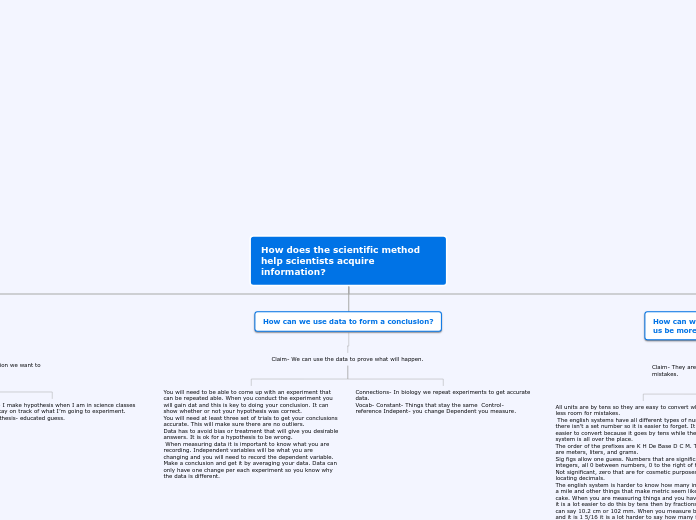
Claim-
We use the scientific method to answer a question we want to know.
The steps to the scientific method help us have a good investigation and can help us get to the correct answer. The steps are make an observation, ask a question, form a hypothesis, test hypothesis with experiment/collect data, analyze data, and finally form a conclusion.
The best observations are when you use as many senses as possible. There are tools that can help us make better observations such as microscopes and thermometers. If it is a good observation a question should come naturally.
Rules for a good scientific question: It has to be able to have an answer and can be tested, can be tested by some experiment or measurment you can do, it builds on what you already know, and when answered, can lead to other questions. Ex. How does plastic affect the wildlife in the Tipton creek.
You need a good hypothesis. It should answer the question and should be testable. The variables will need to be defined. It is not a question. It should also not be an opinion. EX: A bad hypothesis would be blue is the best color. A good hypothesis could be which fertilizer makes plants grow the fastest. An exampple of an experiment could be if you put the same amount of the same grass seed in the same amount of soil in the same spot, but then put different furtilizers you will be able to tell which one is the best by seeing which grass grew the fastest over a certain period of time.
Connections- I make hypothesis when I am in science classes to help me stay on track of what I’m going to experiment.
Vocab- Hypothesis- educated guess.
Claim- We can use the data to prove what will happen.
You will need to be able to come up with an experiment that can be repeated able. When you conduct the experiment you will gain dat and this is key to doing your conclusion. It can show whether or not your hypothesis was correct.
You will need at least three set of trials to get your conclusions accurate. This will make sure there are no outliers.
Data has to avoid bias or treatment that will give you desirable answers. It is ok for a hypothesis to be wrong.
When measuring data it is important to know what you are recording. Independent variables will be what you are changing and you will need to record the dependent variable.
Make a conclusion and get it by averaging your data. Data can only have one change per each experiment so you know why the data is different.
Connections- In biology we repeat experiments to get accurate data.
Vocab- Constant- Things that stay the same Control- reference Indepent- you change Dependent you measure.
Claim- They are easier to use and give you less chances for mistakes.
All units are by tens so they are easy to convert which leaves less room for mistakes.
The english systems have all different types of numbers and there isn’t a set number so it is easier to forget. It is also easier to convert because it goes by tens while the English system is all over the place.
The order of the prefixes are K H De Base D C M. The bases are meters, liters, and grams.
Sig figs allow one guess. Numbers that are significant all no 0 integers, all 0 between numbers, 0 to the right of the decimal. Not significant, zero that are for cosmetic purposes 0 used for locating decimals.
The english system is harder to know how many inches are in a mile and other things that make metric seem like a piece of cake. When you are measuring things and you have to convert it is a lot easier to do this by tens then by fractions. Ex. you can say 10.2 cm or 102 mm. When you measure by inches and it is 1 5/16 it is a lot harder to say how many feet that is.
Connections- It is easier to say 1500 m and know the distance than it is to say around 4921 feet and know how long that distance is.